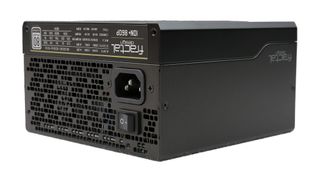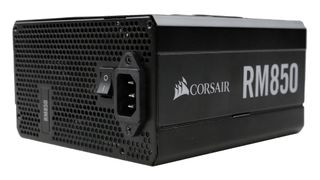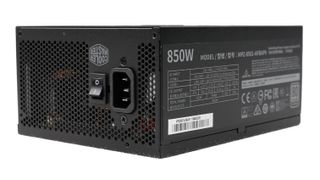Fractal Design ION+ 860P Power Supply Review: Whisper Quiet
Why you can trust Tom's Hardware
Load Regulation, Hold-Up Time, Inrush Current, Efficiency and Noise
To learn more about our PSU tests and methodology, please check out How We Test Power Supply Units.
Primary Rails And 5VSB Load Regulation
The following charts show the main rails' voltage values recorded between a range of 40W up to the PSU's maximum specified load, along with the deviation (in percent). Tight regulation is an important consideration every time we review a power supply because it facilitates constant voltage levels despite varying loads. Tight load regulation also improves system stability, especially under overclocked conditions. At the same time, it applies less stress to the DC-DC converters that many system components utilize.








The load regulation we measure is satisfactory on each rail.
Hold-Up Time
Hold-up time is the amount of time that the system can continue to run without shutting down or rebooting during a power interruption.







The hold-up time we observe exceeds 17ms, while the power-good signal is spot-on at 16ms.
Inrush Current
Inrush current, or switch-on surge, refers to the maximum, instantaneous input current drawn by an electrical device when it is first turned on. A large enough inrush current can cause circuit breakers and fuses to trip. It can also damage switches, relays, and bridge rectifiers. As a result, the lower the inrush current of a PSU right as it is turned on, the better.


Although we measure low inrush current with 115V input, this is not the case with 230V input.
10-110% Load Tests
These tests reveal the PSU’s load regulation and efficiency levels under high ambient temperatures. They also show how the fan speed profile behaves under increased operating temperatures.
| Test # | 12V | 5V | 3.3V | 5VSB | DC/AC (Watts) | Efficiency | Fan Speed | PSU Noise | Temps (In/Out) | PF/AC Volts |
|---|---|---|---|---|---|---|---|---|---|---|
| 1 | 5.338A | 1.996A | 2.004A | 1.003A | 85.828 | 88.273% | 0 RPM | <6.0 dB(A) | 43.85°C | 0.969 |
| 12.028V | 5.016V | 3.299V | 4.985V | 97.230 | 40.30°C | 115.12V | ||||
| 2 | 11.733A | 2.997A | 3.009A | 1.206A | 171.908 | 91.918% | 0 RPM | <6.0 dB(A) | 45.00°C | 0.990 |
| 12.016V | 5.011V | 3.292V | 4.976V | 187.023 | 40.73°C | 115.12V | ||||
| 3 | 18.476A | 3.496A | 3.497A | 1.409A | 257.808 | 92.573% | 0 RPM | <6.0 dB(A) | 46.29°C | 0.997 |
| 12.005V | 5.008V | 3.288V | 4.967V | 278.492 | 41.29°C | 115.12V | ||||
| 4 | 25.230A | 3.993A | 4.008A | 1.611A | 343.806 | 92.299% | 595 RPM | 12.5 dB(A) | 41.78°C | 0.996 |
| 11.993V | 5.013V | 3.295V | 4.966V | 372.493 | 47.71°C | 115.12V | ||||
| 5 | 31.667A | 4.997A | 5.020A | 1.817A | 429.928 | 92.001% | 598 RPM | 12.6 dB(A) | 42.31°C | 0.997 |
| 11.981V | 5.006V | 3.288V | 4.956V | 467.308 | 49.40°C | 115.11V | ||||
| 6 | 38.112A | 6.003A | 6.034A | 2.022A | 516.020 | 91.359% | 602 RPM | 12.6 dB(A) | 42.60°C | 0.998 |
| 11.970V | 5.001V | 3.281V | 4.946V | 564.825 | 51.10°C | 115.11V | ||||
| 7 | 44.572A | 7.009A | 7.056A | 2.229A | 602.156 | 90.746% | 657 RPM | 14.6 dB(A) | 43.01°C | 0.998 |
| 11.959V | 4.996V | 3.274V | 4.936V | 663.559 | 52.44°C | 115.11V | ||||
| 8 | 51.042A | 8.019A | 8.057A | 2.437A | 688.273 | 90.032% | 847 RPM | 22.7 dB(A) | 43.99°C | 0.998 |
| 11.948V | 4.990V | 3.277V | 4.926V | 764.477 | 53.67°C | 115.10V | ||||
| 9 | 57.932A | 8.526A | 8.557A | 2.438A | 773.999 | 89.333% | 972 RPM | 26.8 dB(A) | 44.58°C | 0.998 |
| 11.936V | 4.987V | 3.272V | 4.924V | 866.424 | 55.37°C | 115.10V | ||||
| 10 | 64.594A | 9.029A | 9.090A | 3.063A | 860.005 | 88.546% | 1332 RPM | 36.2 dB(A) | 45.55°C | 0.999 |
| 11.925V | 4.986V | 3.267V | 4.899V | 971.250 | 56.85°C | 115.10V | ||||
| 11 | 71.869A | 9.030A | 9.095A | 3.064A | 945.971 | 87.731% | 1705 RPM | 42.9 dB(A) | 46.56°C | 0.999 |
| 11.914V | 4.985V | 3.266V | 4.897V | 1078.261 | 58.27°C | 115.10V | ||||
| CL1 | 0.154A | 14.005A | 13.999A | 0.000A | 117.609 | 83.815% | 0 RPM | <6.0 dB(A) | 49.30°C | 0.981 |
| 12.004V | 4.994V | 3.273V | 5.053V | 140.319 | 42.30°C | 115.12V | ||||
| CL2 | 71.667A | 1.002A | 1.000A | 1.000A | 868.900 | 89.484% | 914 RPM | 24.9 dB(A) | 45.51°C | 0.999 |
| 11.939V | 5.005V | 3.287V | 4.967V | 971.017 | 56.18°C | 115.09V |
The power supply can handle high operating temperatures, and the performance of its APFC circuit is excellent. Even in the first few tests where the load levels are relatively low, the PF readings are high.
20-80W Load Tests
In the following tests, we measure the PSU's efficiency at loads significantly lower than 10% of its maximum capacity (the lowest load the 80 PLUS standard measures). This is important for representing when a PC is idle with power-saving features turned on.
| Test # | 12V | 5V | 3.3V | 5VSB | DC/AC (Watts) | Efficiency | Fan Speed | PSU Noise | PF/AC Volts |
|---|---|---|---|---|---|---|---|---|---|
| 1 | 1.208A | 0.500A | 0.483A | 0.200A | 19.724 | 61.509% | 0 RPM | <6.0 dB(A) | 0.866 |
| 12.097V | 5.021V | 3.307V | 5.015V | 32.067 | 115.13V | ||||
| 2 | 2.479A | 0.999A | 1.000A | 0.400A | 40.142 | 79.853% | 0 RPM | <6.0 dB(A) | 0.925 |
| 12.032V | 5.016V | 3.302V | 5.004V | 50.270 | 115.12V | ||||
| 3 | 3.675A | 1.499A | 1.488A | 0.601A | 59.620 | 84.684% | 0 RPM | <6.0 dB(A) | 0.949 |
| 12.028V | 5.011V | 3.296V | 4.994V | 70.403 | 115.12V | ||||
| 4 | 4.939A | 1.996A | 2.001A | 0.801A | 80.021 | 87.555% | 0 RPM | <6.0 dB(A) | 0.966 |
| 12.028V | 5.016V | 3.300V | 4.993V | 91.395 | 115.13V |
The unit's fan operates passively during these light loads.
2% or 10W Load Test
Intel plans on raising the ante at efficiency levels under ultra-light loads. So from July 2020, the ATX spec will require 70% and higher efficiency with 115V input. The applied load is only 10W for PSUs with 500W and lower capacities, while for stronger units we dial 2% of their max-rated capacity.
| 12V | 5V | 3.3V | 5VSB | DC/AC (Watts) | Efficiency | PF/AC Volts |
|---|---|---|---|---|---|---|
| 1.259A | 0.253A | 0.252A | 0.052A | 17.598 | 49.980% | 0.882 |
| 12.099V | 5.022V | 3.307V | 5.021V | 35.210 | 115.13V |
The efficiency we observe is much lower than 70%.
Efficiency
Next, we plotted a chart showing the PSU’s efficiency at low loads, and loads from 10 to 110% of its maximum-rated capacity. The higher a PSU’s efficiency, the less energy goes wasted, leading to a reduced carbon footprint and lower electricity bills.




Our results indicate high efficiency under normal loads, though the numbers could be better with light loads.
5VSB Efficiency
| Test # | 5VSB | DC/AC (Watts) | Efficiency | PF/AC Volts |
|---|---|---|---|---|
| 1 | 0.100A | 0.511 | 68.407% | 0.100 |
| 5.106V | 0.747 | 115.12V | ||
| 2 | 0.250A | 1.275 | 74.474% | 0.200 |
| 5.099V | 1.712 | 115.12V | ||
| 3 | 0.550A | 2.798 | 76.365% | 0.315 |
| 5.086V | 3.664 | 115.12V | ||
| 4 | 1.000A | 5.067 | 76.924% | 0.392 |
| 5.066V | 6.587 | 115.12V | ||
| 5 | 1.500A | 7.566 | 77.047% | 0.434 |
| 5.044V | 9.820 | 115.12V | ||
| 6 | 3.000A | 14.914 | 76.537% | 0.487 |
| 4.971V | 19.486 | 115.12V |


The 5VSB rail's circuit needs an update. Its efficiency numbers are very low for today's standards.
Power Consumption In Idle And Standby
| Mode | 12V | 5V | 3.3V | 5VSB | Watts | PF/AC Volts |
|---|---|---|---|---|---|---|
| Idle | 12.088V | 5.048V | 3.308V | 5.047V | 5.535 | 0.407 |
| 115.1V | ||||||
| Standby | 0.105 | 0.013 | ||||
| 115.1V |


Fan RPM, Delta Temperature, And Output Noise
All of our results are obtained between an ambient temperature of 37 to 47 degrees Celsius (98.6 to 116.6 degrees Fahrenheit).
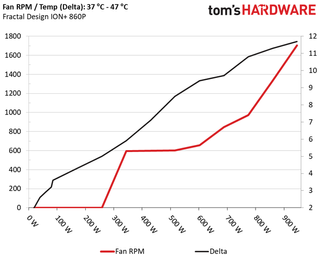
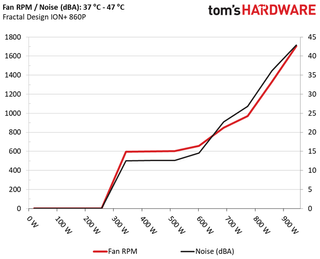
If you don't push the minor rails hard, which reflects real-world usage, the semi-passive fan mode lasts quite a while. Moreover, the fan speed profile is highly relaxed.
The following results were obtained at 30 to 32 degrees Celsius (86 to 89.6 degrees Fahrenheit) ambient temperature.
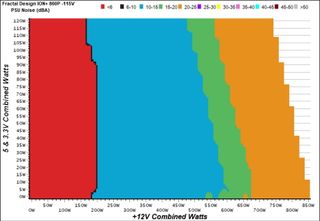
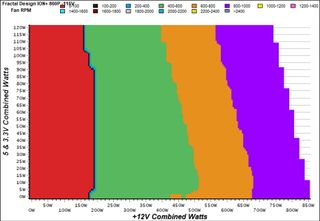
The semi-passive mode lasts up to 170W if you push the minor rails hard. Fortunately, even when the fan starts spinning, noise output remains low.
MORE: Best Power Supplies
MORE: How We Test Power Supplies
MORE: All Power Supply Content
Current page: Load Regulation, Hold-Up Time, Inrush Current, Efficiency and Noise
Prev Page Specifications and Part Analysis Next Page Protection Features, DC Power Sequencing, Cross-Load Tests and Infrared ImagesStay on the Cutting Edge
Join the experts who read Tom's Hardware for the inside track on enthusiast PC tech news — and have for over 25 years. We'll send breaking news and in-depth reviews of CPUs, GPUs, AI, maker hardware and more straight to your inbox.
Aris Mpitziopoulos is a Contributing Editor at Tom's Hardware US, covering PSUs.
